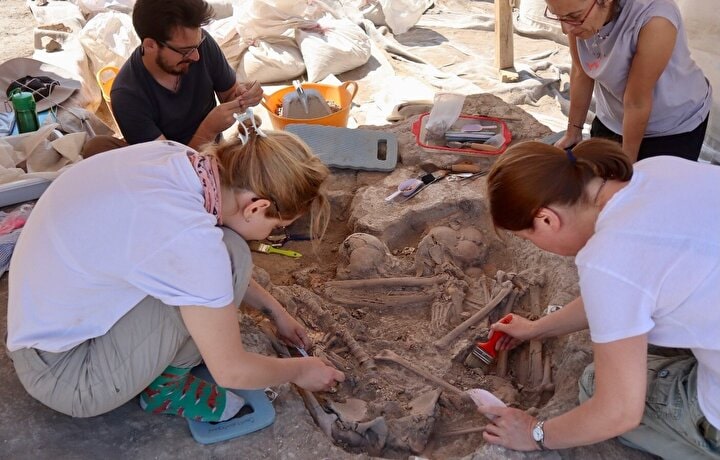
Archaeologists found an 8500-year-old trepanned skull at Çatalhöyük
A skull found in the 9,000-year-old Neolithic settlement of Çatalhöyük in Konya showed traces of trepanation (skull drilling).
Çatalhöyük is a mound near Küçükköy in the Çumra district of Konya, which has been inhabited since 7000 BC.
Çatalhöyük consists of two mound areas. The eastern mound was inhabited during the Neolithic Age and the western one during the Chalcolithic Age.
It is thought that 8 thousand people lived in the settlement. It has layers of settlement where social and cultural ties are strengthened.
📣 Our WhatsApp channel is now LIVE! Stay up-to-date with the latest news and updates, just click here to follow us on WhatsApp and never miss a thing!!
Çatalhöyük Excavation head and Anadolu University faculty member Assoc. Prof. Dr. Ali Umut Türkcan said, “We found a 2.5 centimeter diameter hole in the skull bones of a young male individual during excavations on human skeletons excavated on the floor of a house.”
Assoc. Prof. Dr. Ali Umut Türkcan said the following to AA correspondent:
“Çatalhöyük was inhabited for 16 layers. It is a unique region in the world. It is a settlement where culture progressed very slowly and was abandoned. Our work continues especially in the neighborhood we found in the long street next to the exhibition area, which we call the ‘northern pillbox’. We opened a new area towards the slope of the settlement. While opening that area, we found the second neighborhood. In the new area, we discovered a large building. We concentrated our work on the building, which is about 80 square meters with 5 chambers. Last year, we found a grave covered with a vulture’s claw in a house here. The anthropologists of the excavation made detailed examinations of the grave, which contained 7 people. A young man said: “The drilling on the individual’s skull caught our attention. This is the first time we have seen a clear example of trepanation at Çatalhöyük.”
Türkcan said the academic study on the findings will be shared with the public in the near future.
The study was carried out by Prof. Dr. Handan Üstündağ from Anadolu University, Prof. Dr. Başak Boz from Trakya University, Prof. Dr. Arzu Demirel from Mehmet Akif Ersoy University and graduate student archaeologist Donald Kale.
Prof. Dr. Handan Üstündağ, a faculty member of the Department of Archaeology at Anadolu University, who was part of the anthropology team of the excavation, said:

“A round piece of bone was removed from the side of the skull through a circular incision about 2.5 centimeters in diameter. We found many incision marks indicating that they grazed the scalp during this process. We think this was a therapeutic trepanation. This skeleton was identified as that of a young male aged 18-19 years. There is no indication that the individual lived after this operation. Because there was no sign of healing of the bone tissue. When this surgery was performed, this person was either dying or already dead.”
Üstündağ stated that trepanation was known to have been used for medical treatment in the past and that trepanation was a method used in the treatment of headaches, cerebral hemorrhage, cleaning of broken bone fragments and blood after head trauma, fluid accumulation in the brain and mental disorders.
Emphasizing that there are many examples of trepanation in excavations in Anatolia, Üstündağ concluded his words as follows:
“The example we found in Çatalhöyük is one of the oldest. In the excavations of Aşıklı Höyük near Kızılkaya village in Aksaray and Çayönü Mound in Diyarbakır’s Ergani district, examples of the practice at least 1000 years older than Çatalhöyük were found. At Çatalhöyük, we discovered the first definitive example of trepanation.”
“Our find is one of the oldest examples in Anatolia and differs from other examples from the same period in terms of the size of the pit. Our findings show that people living 8,500 years ago were trying to treat diseases, relieve the pain or suffering of their relatives and prevent deaths. This finding is also remarkable in terms of medical history.”
Cover Photo: AA
You may also like
- A 1700-year-old statue of Pan unearthed during the excavations at Polyeuktos in İstanbul
- The granary was found in the ancient city of Sebaste, founded by the first Roman emperor Augustus
- Donalar Kale Kapı Rock Tomb or Donalar Rock Tomb
- Theater emerges as works continue in ancient city of Perinthos
- Urartian King Argishti’s bronze shield revealed the name of an unknown country
- The religious center of Lycia, the ancient city of Letoon
- Who were the Luwians?
- A new study brings a fresh perspective on the Anatolian origin of the Indo-European languages
- Perhaps the oldest thermal treatment center in the world, which has been in continuous use for 2000 years -Basilica Therma Roman Bath or King’s Daughter-
- The largest synagogue of the ancient world, located in the ancient city of Sardis, is being restored











Leave a Reply